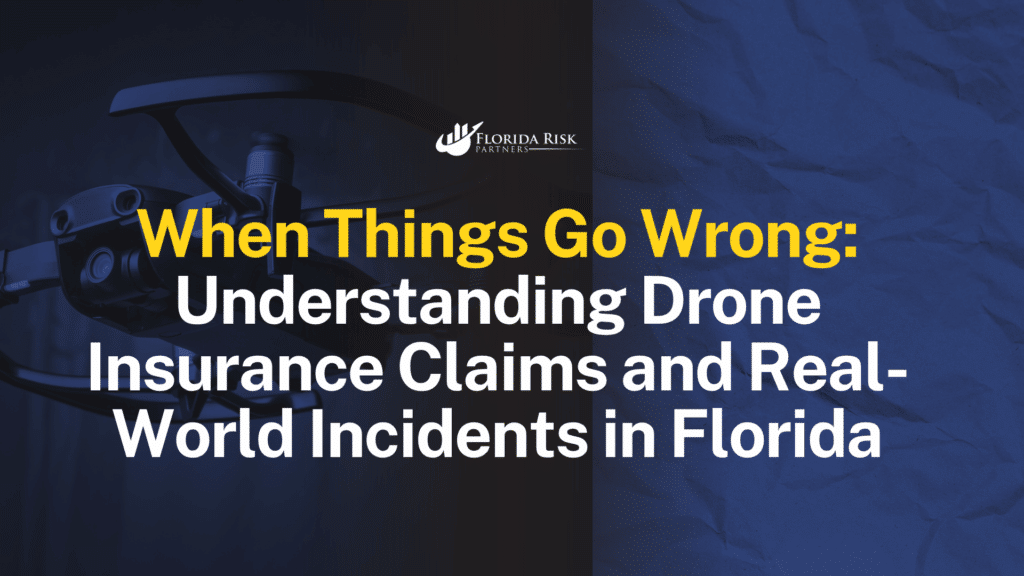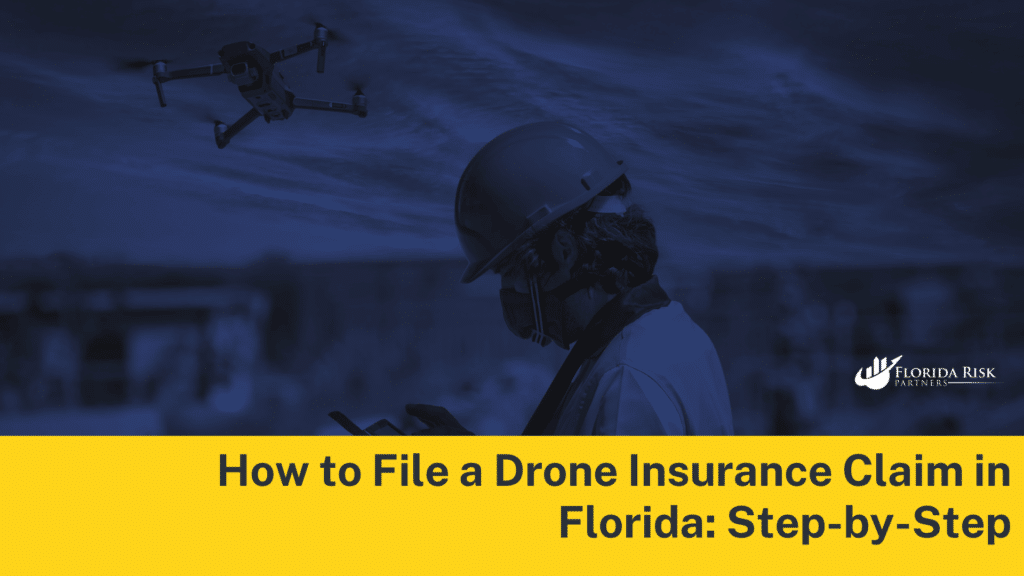-
Main Office: 1434 E. Bloomingdale Ave Valrico, FL 33596-6110
-
Phone: (888) 601-6660
-
Email: info@floridariskpartners.com

Drone operations—whether for commercial use or recreational fun—are thrilling, innovative, and often cost-effective. But like any technology, they come with a very real possibility of failure. And when things go wrong in the Florida sky, the consequences can be serious: property damage, bodily injury, invasion of privacy, or worse.
From drone crashes at crowded events to accidental flyovers of private property, real-world drone incidents in Florida happen more often than many operators expect. While you may follow all FAA guidelines and fly responsibly, unforeseen malfunctions, weather conditions, or human error can lead to accidents. And when they do, knowing how to handle the aftermath is just as important as flying safely in the first place.
In this post, we’re diving deep into Florida drone insurance claims—what causes them, how to avoid them, and what steps you need to take to ensure your drone insurance works when it matters most.
Real Florida Drone Crashes and What We Can Learn From Them
Let’s begin with a few true-to-life examples that highlight the range of incidents drone operators across the state have faced in recent years.
Case 1: Commercial Drone Crashes into Construction Crane in Miami
In 2022, a drone operator was documenting the progress of a new high-rise in downtown Miami for a construction client. While filming a tracking shot, the drone lost GPS signal due to interference from surrounding steel structures. It veered off course and struck a crane arm, falling nearly 200 feet to the street below. Luckily, no one was injured, but the drone was destroyed and a portion of the client’s crane rigging had to be repaired.
Lesson: Even with FAA compliance and proper flight planning, urban environments introduce interference risks. Insurance covered the crane repair and drone replacement—but only because the operator had commercial drone liability coverage in Florida that met the client’s contract requirements.
Case 2: Real Estate Drone Damages Roof in Tampa Suburb
A local real estate agent flying a drone for promotional photos of a luxury listing misjudged proximity to the property’s tile roof during a descent. The drone clipped the eaves, dislodging a tile and damaging the drone’s gimbal. The homeowner requested repairs and questioned whether the agent had the proper authorization to fly on-site.

Lesson: Even “routine” flights carry liability risks. In this case, the drone operator was not licensed under Part 107, and did not carry drone insurance for real estate photography in Florida. The result? A lost listing, out-of-pocket repair costs, and a painful lesson in risk management.
Case 3: Recreational Drone Sparks Privacy Complaint in Sarasota
A hobbyist flying a drone at a public beach accidentally recorded a family on a private condo balcony nearby. The footage, which was shared on social media, caught the attention of one of the condo residents—who filed a complaint under Florida’s Freedom from Unwarranted Surveillance Act. The hobbyist was fined, and the video had to be taken down.
Lesson: Privacy laws in Florida apply to hobbyists too, not just commercial drone operators. Without personal injury liability insurance, even recreational flyers may be exposed to lawsuits or legal penalties.
What Types of Drone Claims Are Most Common in Florida?
Over time, a few recurring themes have emerged in UAV accident reporting and drone insurance claims:
1. Property Damage
This is the most common type of claim. Drones striking cars, roofs, windows, or even boats are frequent occurrences—especially in Florida’s windy or densely populated environments. From real estate neighborhoods to resort zones, even a minor mishap can cause thousands in damages.
2. Bodily Injury
Although rare, bodily injury claims carry high liability potential. Whether from a drone falling on someone or startling them into an accident (such as tripping or falling), these incidents can lead to costly medical claims or lawsuits.
3. Privacy Invasion
As highlighted in the Sarasota example, drone privacy complaints are increasing. This includes footage of private property, unintentional filming of individuals in their homes, or unauthorized use of recorded images. Florida’s privacy laws are strict, and drone operators should always fly with caution near residential areas.
4. Drone Loss or Theft
Equipment-related claims—such as drones lost at sea, damaged during transit, or stolen—are also common. These often fall under hull or payload insurance and may require documentation like flight logs, police reports, or proof of purchase.
5. FAA or Airspace Violations
While these typically result in fines or regulatory penalties, some drone operators try to file claims after crashes in restricted airspace, unaware that flying in those zones can void insurance coverage.
How to File a Drone Insurance Claim in Florida: Step-by-Step
When something does go wrong, filing a claim quickly and correctly can make all the difference. Here’s how to handle the process efficiently:
Step 1: Secure the Scene
If your drone has caused injury or damage:
- Check on anyone who may be injured and call 911 if needed.
- Do not attempt to retrieve your drone from private property without permission.
- Take photos of the scene, including any damage, surroundings, or people involved.

Step 2: Notify Authorities (If Applicable)
If the incident involved injury, major property damage, or occurred in a regulated zone:
- File a report with local law enforcement or airport authorities.
- If required, file a report with the FAA under Advisory Circular 107-1 (particularly if injury or damage exceeds $500).
Step 3: Contact Your Insurance Provider
Provide:
- Your policy number
- A full description of the incident
- Time, location, weather conditions
- Flight logs (many apps like DJI Fly or Autel Sky automatically record this)
- Photos or video evidence
- Any third-party claims or communications
Some platforms, like the quote/bind/issue system offered by Florida Risk Partners, allow policyholders to initiate claims online 24/7.
Step 4: Cooperate with the Investigation
The insurer may request:
- Repair estimates
- Proof of FAA certification (if commercial use)
- Part 107 license
- Proof of consent or permission for location use
- Witness statements or affidavits
Providing complete and accurate information will help expedite your claim.
Step 5: Monitor and Follow Up
You’ll receive communication from the claims adjuster with updates, settlement options, or requests for more information. Keep all communication professional and organized.
What to Look for in a Drone Insurance Policy That Covers Real-World Risks
Not all policies are created equal. If you’re flying drones in Florida, make sure your policy includes:
- Third-party liability coverage for bodily injury and property damage
- Personal and advertising injury coverage (critical for privacy claims)
- Hull and payload coverage for physical damage or theft
- Worldwide or U.S. regional coverage, depending on your operations
- Easy claims filing process with digital access
- Named insured or additional insured flexibility for business contracts
- Exclusions review to ensure no gaps in airspace or equipment use
Best Practices to Minimize Claims and Protect Yourself
While insurance provides peace of mind, prevention is always best. Here are tips to avoid common Florida drone incidents:
- Always perform pre-flight checks, especially in high heat or humidity.
- Check for restricted airspace using FAA’s B4UFLY or AirMap.
- Avoid flying near people, vehicles, or private property unless you have express permission.
- Don’t fly over events, stadiums, or protected wildlife areas.
- Fly during daylight hours only, unless you have a waiver.
- Use geofencing and return-to-home settings on your drone.
- Always keep visual line of sight on your drone.
- Have written contracts and waivers for commercial flights.
Final Thoughts: Claims Aren’t Inevitable—But Preparedness Is
Flying drones in Florida—whether for business or pleasure—is an amazing experience. But when things go wrong, your preparedness will determine how fast you bounce back.
Too often, drone operators assume that because they’re careful or “just flying for fun,” they don’t need insurance. But Florida drone insurance claims happen every week, and the operators who handle them best are those who took the time to prepare.
With the right coverage, smart practices, and a clear understanding of what to do in the event of an incident, you can ensure that your next flight—and your drone business—will stay on course, no matter what turbulence you face.
In next week’s post, we’ll wrap up the series by exploring how Florida drone operators can bundle and customize insurance policies for full-spectrum protection, including drone fleets, multi-use cases, and scalable risk management strategies.
Until then, fly safe, stay legal, and be ready for anything.
Call Us Or
Schedule an Appointment
Select an agent below to view our online calendars and select a day and time that works best for you or call us directly at 888-601-6660. When you use our online calendars, you will receive an email with more information.



